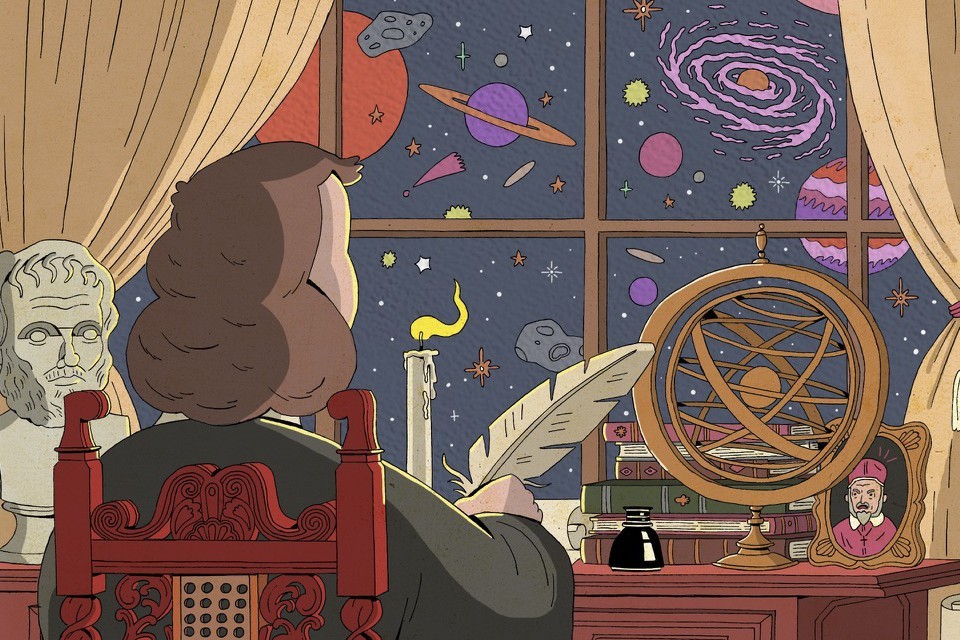
Perpetuating the Myths
By Thony Christie

***This post originally appeared on The Renaissance Mathematicus on May 17th, 2017 – for the original click here***
Since the re-emergence of science in Europe in the High Middle Ages down to the present the relationship between science and religion has been a very complex and multifaceted one that cannot be reduced to a simple formula or a handful of clichés. Many of the practitioners, who produced that science, were themselves active servants of their respective churches and many of their colleagues, whilst not clerics, were devoted believers and deeply religious. On the other hand there were those within the various church communities, who were deeply suspicious of or even openly hostile to the newly won scientific knowledge that they saw as a threat to their beliefs. Over the centuries positions changed constantly and oft radically and any historian, who wishes to investigate and understand that relationship at any particular time or in any given period needs to tread very carefully and above all not to approach their research with any preconceived conclusions or laden down with personal prejudices in one direction or another.
In the nineteenth century just such preconceived conclusions based on prejudice became dominant in the study of the history of science propagated by the publications of the English-American chemist John William Draper and his colleague the American historian and educator Andrew Dickson White. These two scholars propagated what is now know as the Conflict or Draper-White Thesis, which claims that throughout history the forces of science and religion have been in permanent conflict or even war with each other. Draper wrote in his provocatively titled, History of the Conflict between Religion and Science (1874)
The history of Science is not a mere record of isolated discoveries; it is a narrative of the conflict of two contending powers, the expansive force of the human intellect on one side, and the compression arising from traditionary faith and human interests on the other.
In 1876 in his equally provocative The Warfare of Science, White wrote:
In all modern history, interference with science in the supposed interest of religion, no matter how conscientious such interference may have been, has resulted in the direst evils both to religion and to science—and invariably. And, on the other hand, all untrammeled scientific investigation, no matter how dangerous to religion some of its stages may have seemed, for the time, to be, has invariably resulted in the highest good of religion and of science.
Twenty years later White ramped up the heat in his A History of the Warfare of Science with Theology in Christendom.
Draper’s and White’s polemics became widely accepted and Galileo, Darwin and other figures out of the history of science came to be regarded as martyrs of science, persecuted by the bigoted forces of religion.
Throughout the twentieth century historians of science have striven to undo the damage done by the Draper-White thesis and return the history of the relationship between science and religion to the complex and multifaceted reality with which I introduced this post. They were not helped in recent decades by the emergence of the so-called New Atheists and the ill considered and unfortunately often historically ignorant anti-religious polemics spewed out by the likes of Richard Dawkins and Sam Harris, supposedly in the name of freedom of thought. I have, although a life-long atheist myself, on more than one occasion taken up arms, on this blog, against the sweeping anti-religious generalisations with respect to the history of science spouted by the new atheist hordes.
So it was with more than slight sense of despair that I read the preview in The Atlantic of
A Graphic Novel About 17th-Century Philosophy with the title Heretics!
This is described by its publishers the Princeton University Press as follows:
An entertaining, enlightening, and humorous graphic narrative of the dangerous thinkers who laid the foundation of modern thought
The Atlantic’s review/preview confirmed my darkest suspicions. We get informed:
Dark spots across the sun, men burned at the stake, an all-powerful church that brooks no idea outside its dogma—there is no subject so imbued with drama, intrigue, and fast-paced action as 17th-century Western philosophy. And thus no medium does it justice like the graphic novel.
No, really.
Heretics!, a graphic novel by Steven and Ben Nadler, introduces readers to what is arguably the most interesting, important, and consequential period in the history of Western philosophy. While respecting recent scholarship on 17th-century thought, [my emphasis] the Nadlers sought to make these stories and ideas as accessible and engaging to as broad an audience as possible without condescension. At times, this called for some historical liberties and anachronism. (Full disclosure: there were no laptop computers or iPods in the 17th century.)
We are back in Draper-White territory with a vengeance! The last thing that the Nadlers do is to respect recent scholarship, in fact they turn the clock back a long way, deliberately avoiding all the work done by modern historians of science.
The sample chapter provided by The Atlantic starts with Giordano Bruno, who else, much loved as a martyr for science by the new atheist hordes.
Source: The Atlantic
We see here that, as usual, Bruno’s cosmology is featured large, whilst his theological views are tucked away in the corner. Just two comments, Bruno was by no stretch of the imagination a scientist, read this wonderful essay by Tim O’Neill if you don’t believe me, and his “highly unorthodox” theological views included denial of the trinity, denial of Jesus’ divinity and denial of the virgin birth any one of which would have got him a free roasting courtesy of the Catholic Church if he had never written a single word about cosmology.
Up next, prime witness for the prosecution, who else but our old friend Galileo Galilei. We get the hoary old cliché of him throwing rocks off the Leaning Tower of Pisa, which he almost certainly never did.
We now move on to Galileo the astronomer,
Source: The Atlantic
who having made his telescopic discoveries claims that, “Copernicus was right.”
Source: The Atlantic
Know what, in 1615 Galileo was very careful not to claim that because he knew that it was a claim that he couldn’t back up. What he did do, which brought him into conflict with the Church was to suggest that the Church should change its interpretations of the Bible, definitely not on for a mere mathematician in the middle of the Counter Reformation and for which he got, not unsurprisingly, rapped over the knuckles. In 1616 Pope Paul V did not condemn Copernicus’s theory as heresy, in fact no pope ever did.
We then have Galileo sulking in his room and he is going to show them! In fact Galileo courted the Catholic Church and was a favourite of the papal court in Rome; he received official permission from Pope Urban VIII to write his Diologo. I’m not going to go into the very complex detail as to why this backfired but a couple of short comments are necessary here. At that time the heliocentric theory did not do a much better job of explain the phenomena in the heavens and on earth. Galileo’s book is strong on polemic and weak on actual proofs. Also, and I get tired of pointing this out, Galileo was not condemned as a heretic but found guilty of grave suspicion of heresy. There is a massive legal difference between the two charges. Paying attention to the fine detail is what makes for a good historian. We close, of course with the classic cliché, “And yet the earth moves.” No, he didn’t say that!
Source: The Atlantic
We then get a comic book description of the differences between the philosophies of Aristotle and Descartes that unsurprisingly doesn’t do either of them justice. All of this is of course only a lead up to the fact that Descartes decided not to publish his early work explicating his philosophy including his belief in heliocentricity, Traité du monde et de la lumière, on hearing of Galileo’s trial and punishment. This is dealt with by the Nadlers with a piece of slapstick humour, “Zut alors! I don’t want to get into trouble too!” Has anybody ever actually heard a Frenchman say “Zut alors!”?
Source: The Atlantic
This episode in intellectual history is actually of great interest because as far as is known Descartes is the only author in the seventeenth century who withdrew a book from publication because of the Pope’s edict against teaching heliocentricity. He appears to have done so not out of fear for his own safety but out of respect for his Jesuit teachers, whom he did not wish to embarrass. This was rather strange as other Jesuits and students of Jesuit academies wrote and published books on heliocentrism merely prefacing them with the disclaimer that the Holy Mother Church in its wisdom has correctly condemned this theory but it’s still quite fun to play with it hypothetically. The Church rarely complained and appearances were maintained.
This very superficial and historically highly inaccurate comic book in no way does justice to its subject but will do a lot of damage to the efforts of historians of science to present an accurate and balanced picture of the complex historical relationship between science and religion.
For anybody who is interested in the real story I recommend John Hadley Brooke’s classic Science and Religion: Some Historical Perspectives (1991) and Peter Harrison’s, soon to be equally classic, The Territories of Science and Religion (2015). On reading The Atlantic review/preview Peter Harrison tweeted the following:
Oh dear…. Not the optimal format for communicating the complexities of history – Peter Harrison (@uqharri)
James Ungureanu another expert on the relations between science, religion and culture also tweeted his despair on reading The Atlantic review/preview:
When I saw this earlier, I died a little. It must be right because it’s funny! – James C Ungureanu (@JamesCUngureanu)
Thony Christie is a historian of science whose blog The Renaissance Mathematicus is dedicated to exploring the wonderful complications and nuances from the history of scientific endeavour, and in particular to debunking some of the most persistent myths which abound in popular culture. For more on Thony and the blog, click here. Thony can be found on Twitter @rmathematicus






